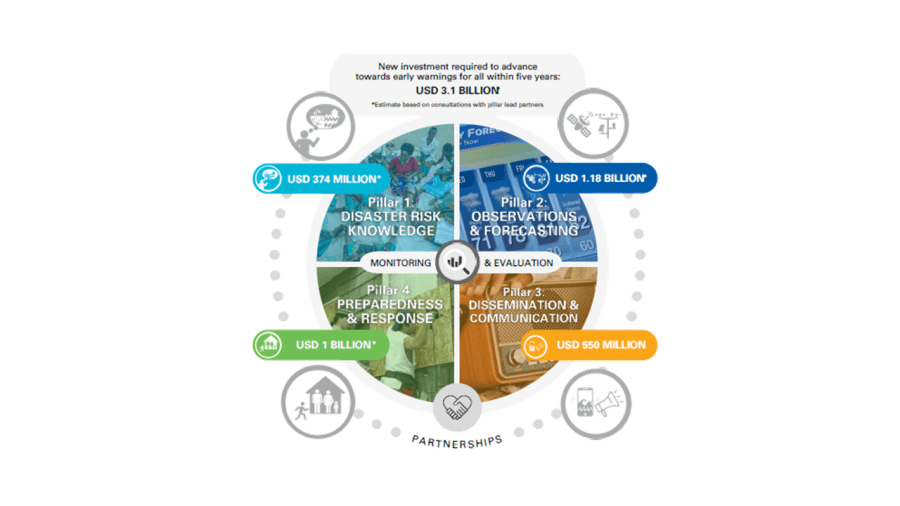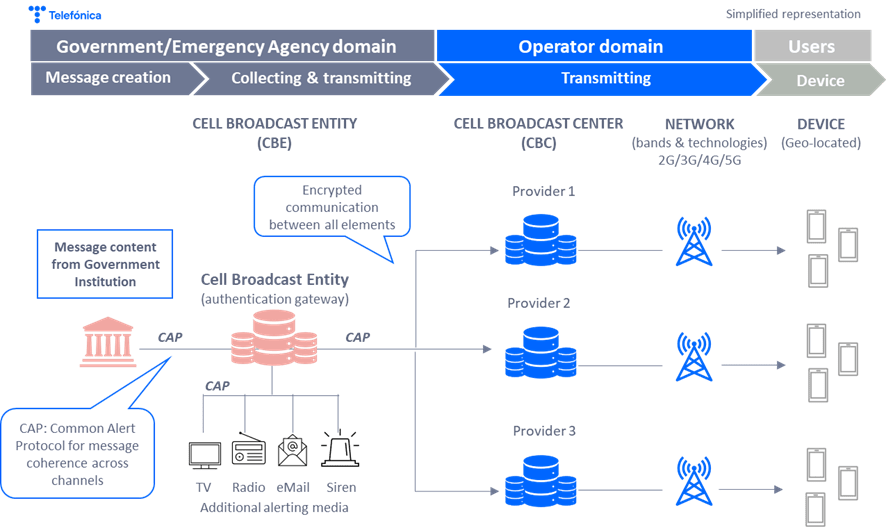A few days ago, both in Spain and in Germany, mobile phones were ringing off the hook, but not by chance. In the case of Spain, in Madrid, the reason was the launch for the first time of the public warning service, a measure to protect the population from the heavy rains that hit the region. Meanwhile, in Germany, the annual rehearsal took place as part of an ongoing effort to familiarise the population with this new public service and whose purpose is to ensure personal safety.
Sadly, recent events highlight the growing need for technological solutions that can quickly save lives and mitigate damage in a world where natural disasters are occurring more frequently.
Early warning systems are a vital shield
The increase in the number of natural disasters related to climate change, coupled with large gaps in early warning systems in different countries, has led to the United Nations “Early Warnings for All” initiative.
Launched in November 2022, the initiative aims to ensure that everyone is covered by an early warning system by 2027. This is a crucial step towards greater security worldwide.
A comprehensive and efficient early warning system involves four fundamental functions: risk assessment, monitoring and issuing warnings, communication and dissemination, and response capability. The Action Plan of the initiative places the ITU at the forefront of Pillar 3: dissemination and communication of warnings. In this context, the telecommunications operators have an essential role to play in guaranteeing the effective dissemination and communication of early warnings, ensuring that they reach as many people as possible.

The expansion of public warning systems to mobile devices
Until the beginning of the 21st century, authorities have used traditional media such as radio, television, and newspapers, as well as sirens, to disseminate warning messages to the population in the event of sudden disasters. However, thanks to technology and digitalisation, the possibilities for alerting the population have expanded.
The availability of broadband networks and the high penetration of mobile devices with internet access, especially with access to Apps and social networks, have turned the mobile network and devices into essential channels for disseminating mass alerts.
As a result, today’s most modern and effective early warning systems rely on multi-channel approaches to deliver alerts uniformly across multiple channels, including mobile devices, increasing the effectiveness of the service for the benefit of communities and individuals.
The mobile technology behind early warning systems
In 2006, the European Telecommunications Standards Institute (ETSI) responded to the growing interest in early warning systems after the 2004 tsunami and 2005 Hurricane Katrina with a key report that laid the groundwork for a mobile-based early warning service.
Essential requirements included reaching 97% of the population in real time, handling large volumes of messages on congested networks, ensuring security and privacy, and maintaining high geographic coverage.
The ETSI report concluded that cell broadcast and short message service (SMS) were the most appropriate technologies. Cell broadcast, however, excels at transmitting messages in real time to millions of mobile devices in specific geographic areas, anonymously, including roamers.
Unlike the “one-to-one” approach of SMS, cell broadcast does not require pre-registration of numbers or maintenance of databases to preserve users’ privacy. The system allows only authorised personnel access to send the alert and can display messages in multiple languages with automatic acoustic signals. This makes it more efficient and secure. Similarly, a dedicated channel eliminates the risks of network congestion in mass messaging situations. And most mobile phones, by default, can receive the alert with information about the danger and recommendations for immediate action.

The role of telecommunications operators, governments, and regulatory frameworks
The content of alert messages is the sole responsibility of governmental and emergency authorities, while telecommunications operators provide the network infrastructure and act as mere transmitters.
These electronic communications-based systems rely on telecommunications infrastructure. The availability of reliable and quality networks is essential for alerting the population in emergency situations.

This dependence has led authorities to accelerate their implementation through regulation. Regulation, such as Article 110 of the European Electronic Communications Code has accelerated the implementation of these systems in Europe. Countries such as Germany and Spain activated ES-Alert and DE-Alert, respectively with cell broadcast, in February 2023, following the European Code regulation.
Other countries such as Chile, Peru or Mexico also regulate the homologation of devices to ensure their compatibility with the service, while in other cases, the obligation to inform consumers about the service has also been introduced as a consumer right.
Telefónica and early warning systems
In some countries where Telefónica operates, such as Spain, Germany, UK, Chile, Peru, Mexico and soon Ecuador, cell broadcast technology is the most commonly used technology for early warning systems. In Brazil, the system is evolving from SMS to cell broadcast with deployment planned for the end of 2023. Even so, there is still a way to go for the generalisation of these systems worldwide.
Public policies associated with early warning systems
Telefónica believes that, in order to accelerate the deployment of these systems, collaboration between the public and private sectors plays an essential role, from operators, device manufacturers and software vendors, among others. In particular, mobile operators provide technical expertise and knowledge, and make their teams available to emergency centres.
Similarly, the existence of clear regulatory frameworks and incentives aligned with the financing of these services is also crucial to boost the uptake of these systems. As an example, the EU’s regulatory approach has proven to be an effective way to accelerate the adoption of public warning systems in Europe.
It is also relevant to take into account the different technologies available and the national and regional realities, such as the range of available devices. However, cell broadcasting should be prioritised for its advantages and integrated into existing national emergency plans. Similarly, promoting the homologation of devices is key to ensuring the effectiveness of alert dissemination.
Additionally, a multi-channel approach to early warning systems would be optimal. In such a case, developing a common warning protocol is essential to maintain message consistency across all channels.
Last but not least, building public awareness. Preparing the population and increasing their confidence with regular testing and awareness campaigns will boost effectiveness.









